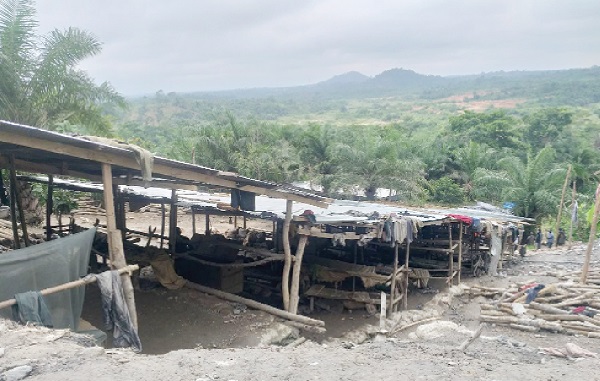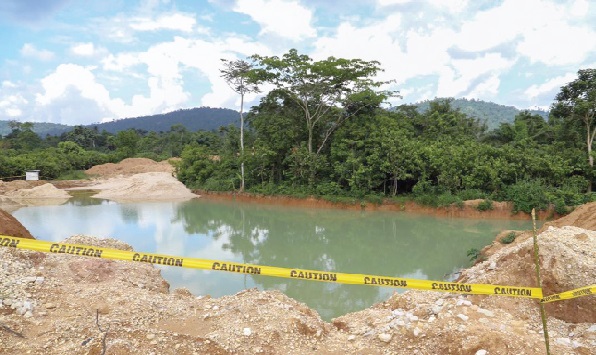
Community mining: Sure bet to winning galamsey fight?
Issah Mumuni and Kwaku Bimpeh were red alert at the border. They were armed to the teeth. Each of them had locally manufactured single-barreled gun.
Buckled to their chest were cartridge belts filled with ammunition. They also wore traditional dresses implanted with amulets and talisman. Completing the fearful costume were animal tails tied to their hands.
Advertisement
They looked like men dressed for battle, but they were not warriors. Rather, security guards on duty at the community mining site at Tinga in the Bole District in the Savannah Region.
The site had been one of the hot spots for illegal mining activities popularly called ‘galamsey’ in the country.
It was this site that I visited on June 22, 2020 with the Minister of Lands and Natural Resources, Mr Kwaku Asomah-Cheremeh and other officials from the ministry.

The Minister of Lands and Natural Resources, Mr Kwaku Asomah-Cheremeh, inspecting activities at the Tinga community mining site
Observation
About 200 metres away from the mining site, which host at least 50 underground pits, were a string of structures that served as accommodation for the miners and petty traders who thronged the area to sell food and other provisions.
When we got to the mining site itself, there were traces of the destructive activities of galamsey. Although the area had been adopted for community mining, the environment was yet to recover from the harm caused by the illegal miners.
A number of deep pits were seen all over the place since the mining module there was underground. Heaps of ore that had been mined were yet to be crushed and processed to extract the valuable mineral.
Equipment such as the crusher, used for crushing the ore; mill, used for grinding the ore into fine particles; sluice box, where the fine materials are washed and the gold trapped by means of gravity; were seen at the site.
The National Communication Officer of the Ghana National Association of Small-scale Miners (GNASSM), Mr Abdul Razak Alhassan, who took the team to the site, said the current recovery rate for gold at the site was 30 per cent.
He said the people of Tinga and its environs were banking their hopes on the Community Mining Scheme (CMS) introduced by the government to improve on their mining operations.

This is the basic way miners at Tinga extract gold from ore
CMS
The CMS, which is being implemented by the Minerals Commission, is a small scale mining operation in line with Sections 81 – 99 of the Minerals and Mining Act, 2006 (Act 703). It is an initiative by the government to promote local participation in the SSM sector as a measure to fight galamsey.
Mr Asomah-Cheremeh, succinctly defined CMS as “mining of the people, by the people and for the people” because the scheme is reserved for only Ghanaians.
For his part, the Chief Executive Officer (CEO) of the Minerals Commission, Mr Kwaku Antwi-Boasiako, explained that the CMS would be governed by a code of practice as stated in Regulations 475 and 515 of the Minerals and Mining (Health, Safety and Technical) Regulations, 2012 (L.I. 2182).
He added that unlike galamsey, where miners engaged in speculative mining with its resultant environmental devastations, CMS would utilise land that had been designated by the minister responsible for Mines in accordance with Section 89 of Act 703.
“Currently, there are 123 designated areas (5000 square kilometres) for SSM operations across the country,” he said, adding “these shall be supervised by a Community Mining Oversight Committee (CMOC).”
To ensure that the environment, including land and water resources are protected under the CMS, state institutions such as the Environmental Protection Agency (EPA), Water Resources Commission (WRC) and the Ghana Geological Survey Authority (GGSA) are supporting the Minerals Commission to implement the scheme.
Additionally, Metropolitan, Municipal and District Chief Executives (MMDCEs) and the security agencies have been tasked to help enforce compliance with the best practices.
A CMOC, made up of stakeholders such as traditional authorities, the Ghana Education Service (GES), GNASSM and religious leaders have the responsibility to ensure that the operations of the CMS does not pose any challenges to the community.
Among other things, the committee has the responsibility to ensure that no child participates in mining at the peril of their life and education.
So far, seven of the CMS have been launched in the Obuasi Municipality, Obuasi East District, Amansie West and Amansie Central districts all in the Ashanti Region as well as Tinga in the Bole District in the Savannah Region.
Prospects
Apart from being a bold move towards arresting galamsey, the CMS has huge prospects for job creation, poverty reduction, opening up of the local economy and improvement in government revenue.
For instance, figures from the Minerals Commission show that the CMS was estimated to create 80,000 direct jobs in mining communities, while the multiplier effect could reach some 161,000 others. This brings to 242,400, the number of people who will have their bread buttered if the scheme is sustained.
Mr Asomah-Cheremeh described the CMS as a “game changer” in domestic revenue mobilisation because under the scheme, the metropolitan, municipal and district assemblies (MMDAs) would have updated data on all persons in the SSM sector for accurate payment of taxes and royalties.
Caveat
Mr Aryeh, however, cautioned that if the prospects of the CMS were to be realised, there was the need for strict adherence to safety protocols such as the wearing of personal protection equipment (PPE); improved ventilation at sites that operated underground and re-engineering of underground pits to ensure that it rested on competent grounds.
He underscored the need for improved sanitation conditions at the CMS sites to prevent the spread of diseases.
One of the major threats galamsey operations poses to the environment is the massive destruction of hundreds of hectares of land that weep for restoration of their health. Mr Aryeh said land reclamation must be prioritised under the CMS.
"I want to stress that under the CMS, more emphasis should be placed on reclamation such that as they stock pile the top soil, they reclaim it to protect the environment," he added.



